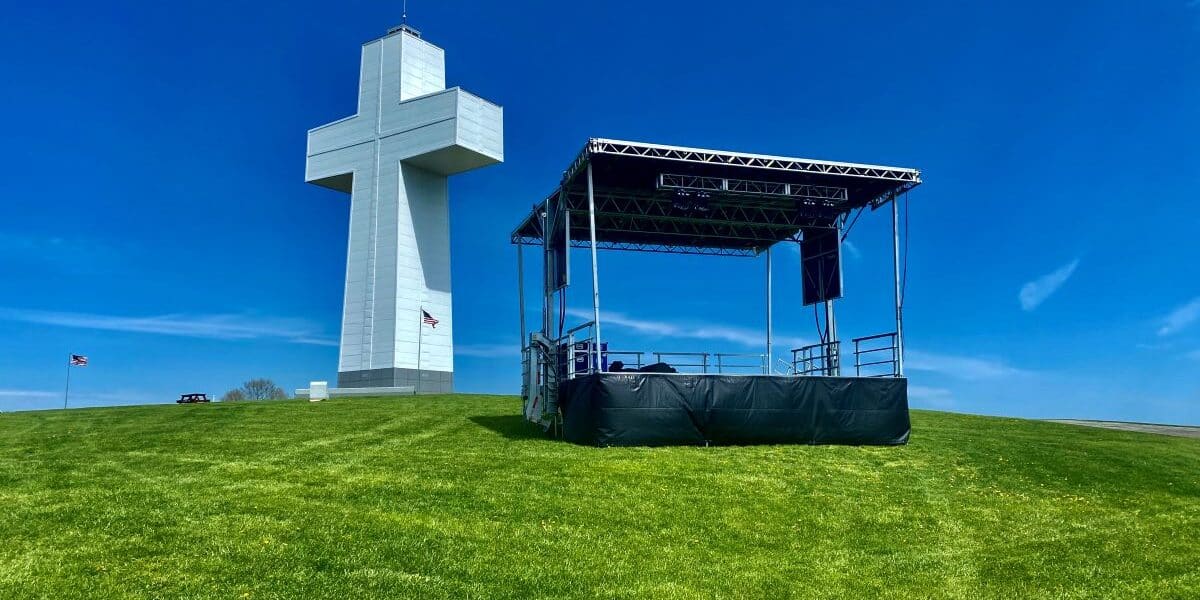Outdoor celebrations provide a refreshing change of scenery from the usual indoor church setting. Nature’s beauty can enhance the spiritual experience by creating a relaxed and serene atmosphere. Outdoor venues often provide more space, allowing for larger congregations to gather without feeling cramped. This can be especially beneficial for special events or holidays that attract larger crowds.
However, it’s important to note that outdoor celebrations also come with challenges such as weather uncertainty and the need for suitable outdoor facilities, such as a celebration platform or performance stage.
Choosing a stage is a critical decision for your church. Not only will your choice shape all future live events you hold, but it will also determine the operations, creative possibilities, and safety of those who work or gather around the structure.
When researching the right stage, you need to consider some key factors—Supplier, Product, and Safety/Emergency Procedures—and receive appropriate answers to basic questions about each of these elements.
The Supplier and Manufacturing Approach
A stage is a temporary structure that gets repeatedly mounted, used, and disassembled in different locations. Because of this, its engineering is specialized. The engineers who designed and approved your stage must not only be qualified, but also experienced in the specific task of developing temporary outdoor structures.
The first question to ask of a supplier is simple: “Is this product designed to be utilized outdoor?”
Several factors come into play when it comes to installing a structure outdoors. First, is access possible to position the stage where you want it? Next, is the terrain flat or uneven? Does the ground have sufficient capacity to support the stage load? Do the workers have all the required personal protective equipment? Will most of the work be done from the ground or up in the air?
A hydraulic mobile stage allows the equipment, banners and windwalls to be installed from the ground before the roof is raised avoiding the work at heights. In any case, you need to ensure that the chosen stage and provider address all these points with no compromise on safety.
Finally, what defines the performance of an outdoor stage is its ability to withstand the whims of Mother Nature. Strong winds can push against your banners and windwalls and add significant loads by moving the equipment attached to the roof. A structure designed for outdoor use takes all of this into account in its design and operation.
Whether it’s for purchasing or renting a stage, it’s important to ensure that your supplier provides a structure for outdoor use and not an indoor solution adapted for outdoor use. This could save you a lot of headaches.
The Product
At no point in the staging process is it acceptable to take safety risks. That means a stage needs to remain safe, strong, and stable from the time it arrives on-site as a trailer, through the installation process, during its operation, and through its dismantle. The stage must also be able to securely support the rigging load required for your event. These are iron-clad rules that stand even in situations of high winds or extreme weather.
Can the supplier provide technical drawings, rigging plans, and operating manuals? If not, this should raise a flag for you to dig deeper. No matter what, ask for a signed confirmation from a certified engineer that the structure is stable and properly installed.
Outdoor venues can provide a picturesque backdrop for ceremonies. It’s a great bonus when the chosen structure provides banner-hanging solutions and creative decor elements that blend in as much as possible with your environment. A freestanding structure, which doesn’t require cables and ballasts, adds to the aesthetics and, most importantly, will not damage your site.
A good structure must be operated by a competent technician. The two go hand in hand. This way, you can maximize the potential of your stage and use it in a variety of events.
The Safety/Emergency Procedures
Because a stage is a center around which crowds of people gather, stage failure can have truly tragic consequences. For that reason, the supplier should provide a plan for contingencies, such as malfunction, hazardous weather, or other unexpected situations, such as overloading, heavy rain or lightning.
The stage’s Operations Management Plan should document all potential unexpected outcomes and provide secure and well-thought-out procedures for addressing unforeseen events long before you’ll ever face them.
Promoters and attendees alike hope their event occurs on a pleasant sunny day. But staging suppliers should have a system for carefully monitoring the weather before, during, and after the event. Ask your supplier how they monitor climate and what kinds of plans they have in place for keeping the stage safe in the face of inclement weather.
This is where you probably want to put your focus on. That’s why your supplier must take care of the safety plans and weather management. This way, you can put these concerns out of your mind.
Trust Yourself
For outsiders to the world of events, these questions may seem technical or arcane, but for staging professionals, they are everyday discussions. World-renowned staging professionals love to show off their safety credentials and certainly won’t mind if you ask them to prove their claims.
Never be afraid to ask questions; this is your event, after all, and your safety. You deserve the peace of mind that comes from quality staging, and by asking the questions above, you can achieve it.
For the past decade, Alexis Delage has been serving as a member of the management team at Stageline, a pioneer in mobile staging technology with over 35 years of experience in engineering, design & manufacturing of hydraulic mobile stages, www.stageline.com.












